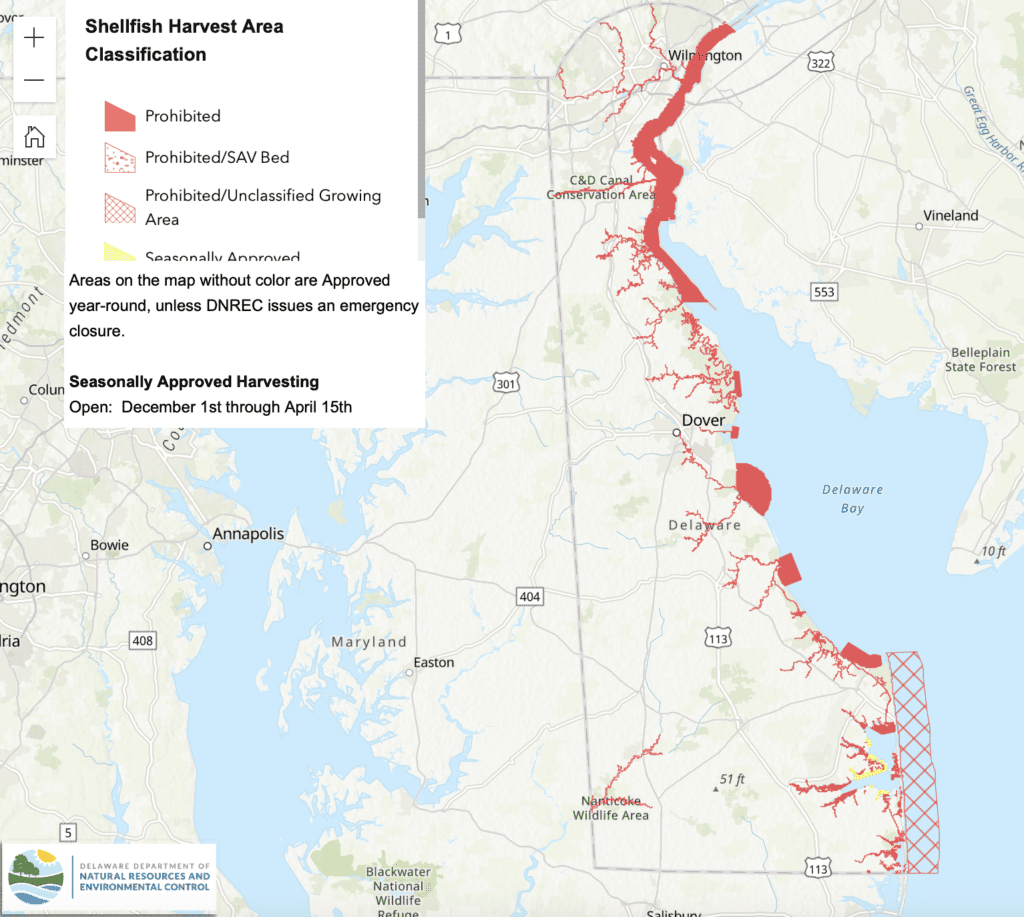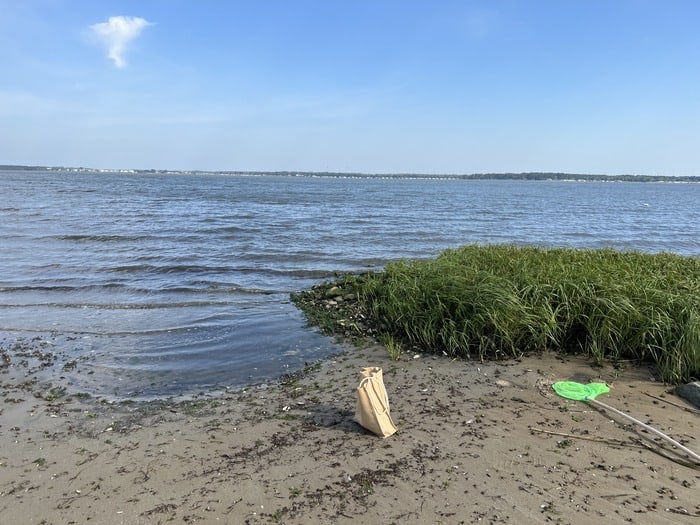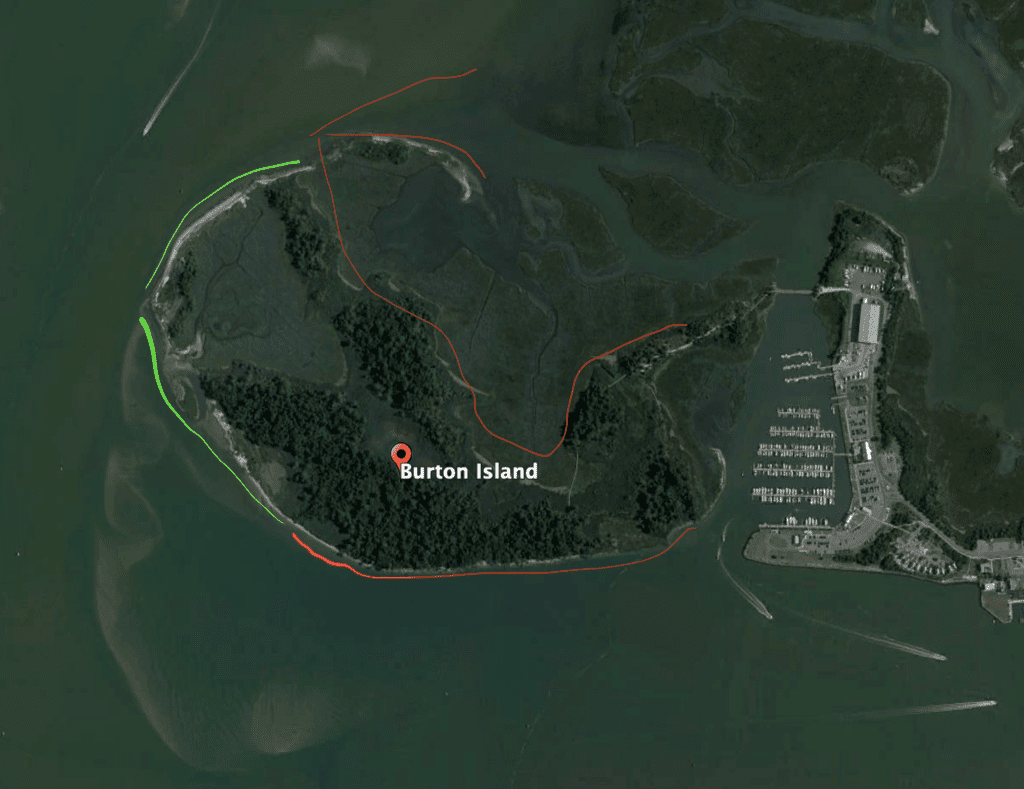How to go Clamming in Delaware (Spots, Technique, & Rules)
Clamming in Delaware can be as easy as swishing your feet in the sand in shin-high water, and picking up hard-shelled clams as you find them. They’re a delicacy in the First State, and catching them makes for a fun time on the water. So, let’s go over a few techniques for catching them, where to do so, and regulations that come with it.
How to Catch Hard Shell Clams in Delaware
The first thing you want to do to collect hardshell clams is to find a shoreline with shallow water and a sandy shoreline. I go over a few specific spots along the Delaware Shoreline later, so for right now you just need to understand where the clams are. You don’t want a muddy spot, since this is harder to rake.
Technique 1: Feeling with your feet.
When you have your clamming spot, you have a few options. The easiest and cheapest option is to put on some water shoes and dig with your feet through the sand where the water doesn’t go past your knees. You will want to dig a few inches in the sand because that’s where the clams like to hide. As you feel rock-like lumps in the water, reach down and see if it’s a clam. Since you’re in a sandy-bottomed spot, this will most often be a clam!
I can’t stress the importance of water shoes here. Unfortunately, it’s easy to cut your feet on the Delaware Seashore from discarded trash and bottles. Protect yourself and wear water shoes! I recommend this pair on Amazon.com (Affiliate link).
There’s a few reasons why I don’t like this method. It’s tiring, inefficient, and I don’t like reaching into murky water. I’ve picked up a few horseshoe crabs and they freak me out. I prefer one of the next methods: the clam rake.
Technique 2: Raking with a garden rake.
For this method, I feel that the title is explanatory. Take a garden rake and head to the spot where you go clamming, and start raking the sandy-bottom in knee-deep water. You will want to dig about two inches deep as you scrape the bottom. Eventually, you’ll hear a ding like you hit a rock. It’s probably a clam! You’ll have to reach down and grab the clam, then carry it with a bag or bucket.
This method is much easier than feeling for clams for your feet, but you still have to reach down and find the clam in the murky water. You will still need water shoes. It shouldn’t cost anything either, unless you don’t have a garden rake at home. I wouldn’t recommend buying a new rake for this, since repeated exposure to saltwater while clamming will ruin a rake after a few seasons. To preserve your rake, rinse your rake with hose water immediately after clamming.
Technique 3: A Clam Rake (My favorite).
The third option is to use a clam rake. The idea is the same as the previous method, but this time you’re going to use a clam rake instead of a normal rake. A clam rake has longer prongs, which dig deeper into the sand. It also has a small metal cage that captures the clams as you rake them up. Now you don’t have to reach down and pick up the clams! This makes clamming much faster, easier, and way more efficient compared to the other two methods.
You will still need water shoes to protect your feet, and a net or container to carry the clams as you find them. I recommend the Danielson Clamming Rake on Amazon over any other clamming rake. This one will last the longest, and has higher-quality materials compared to other rakes (Affiliate Link).
Delaware Clamming Rules & Regulations
Now that you know how to find a clam, you need to familiarize yourself with Delaware’s Clamming Regulations. These rules are in place to protect and preserve the hardshell clam population for today and for future generations.
Disclaimer: This is not an official copy of the laws or regulations. This explanation of the laws and regulations is correct as of the date specified. It is the fisherman’s responsibility to know the laws and regulations in effect at any given time.
| Season | Delaware’s clamming season is open year round, and most popular in the summer months. Select areas in the Inland Bays are restricted from clamming due to high bacteria levels, but are allowed from December 1 to April 15. See Delaware’s Shellfish Harvest Area Interactive Map for these restricted areas. |
| Daily Limits | Delaware Residents with a Delaware fishing license are allowed to keep 100 legal-sized hardshell clams a day. Non-residents with a Delaware fishing license may keep 50 legal-sized hardshell clams a day. |
| Legal Size | For a hardshell clam to be of legal size, it must measure at least 1.5 inches across its length. This can be measured with a clam gauge or ruler. |
| License | An active Delaware Fishing License must be purchased and renewed every year to go recreational clamming in the State of Delaware. This can be purchased on Delaware’s DNR Website. I have a tutorial on how to do so here. |

(Source)
Clamming Spots in Delaware
Clamming in Delaware is restricted by the state’s DNR. Algae, pollution, and other factors cause shellfish in certain areas to be unsafe to consume. For this reason, the DNR restricts clamming in these areas. Tidal rivers, rivers, and impoundments are restricted from clamming. Marshland areas boxed in by PVC pipes are restricted and usually marked with a “No Shellfish Harvesting” sign. This is a commercial clam growing area, and you’ll get in trouble for clamming here.
You can explore where you can and can’t go clamming at Delaware’s Shellfish Harvest Area Interactive Map. I took a screenshot you can view here:

I found a few spots with public parking where you can go clamming by looking at Google Maps and using my intuition as a Delaware local. I was right on the money, too. After talking to local clammers, I now know for sure that these spots will have clams. They’re just crowded. So, keep that in mind when clamming.
You can find your own secret spot by looking at water-depth maps of the Indian River and Assawoman Bay that aren’t in restricted shellfish areas.
Tower Road, off of Route 1
I’ve always passed this spot on my way to Bethany, but I never knew it was such a popular clamming spot! The water is shallow, sandy, and flat here making it the perfect spot to drag your clam rake. It can, unfortunately, get crowded. I recommend walking south along the beach until you get closer to the marshier area before you start raking.
This spot comes with parking for around 60 vehicles and porta-potties. Like all Delaware parks, you need to take your trash with you. I like that parking here is right on the water. So, it’s not too far of a walk from your vehicle to the water.
Holt’s Landing State Park
I’ve recommending Holt’s Landing State Park as the go-to spot to go crabbing in Delaware, and now I want to do the same for clamming. You can easily drag a clam rake along the shore around the pier, between the seagrass and the rock barriers, and the shoreline to the left of the fishing and crabbing pier.
This spot has plenty of parking that’s a short walk from the shoreline. There are actual bathrooms (not porta-potties) that are clean and well-kept. If clamming gets slow, there are walking trails and a crabbing / fishing pier for other activities.

Here’s a picture I took from the shoreline at Holt’s Landing State Park. The water here is shallow and sandy, perfect for clamming. Just wear water shoes and look out for horseshoe crabs!
Burton Island, DE
Burton Island, a part of Delaware Seashore State Park, has a part of its shoreline that’s open to clamming. If you don’t know, this park is between Rehoboth and Bethany. The shoreline is a bit of a hike, but it’s lesser-known than the other spots on this list.
If you walk along the shoreline to the West sandy beach, You’re in a great clamming spot. Bear in mind that the East, South, and North shore of Burton Island is restricted from clamming. Take a look at the diagram below to see where is allowed and where isn’t. The green shoreline is good for clamming, while the red is restricted.

I would recommend kayaking or paddle boarding to this spot when the water isn’t too rough. You can rent one from the parking spot at the Marina.

